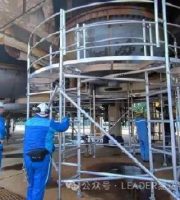When horizontal directional drilling has not been invented, to lay pipelines through rivers or obstacles, it needs to be completed by means of digging pits and sinking pipes, which is not only low efficiency but also high cost.
When drilling the pilot hole, a bit slightly larger than the outer diameter of the drill pipe shall be installed at the head of the drill tool.
Site layout: at the crossing part of horizontal directional drilling, a working pit is set at the starting point of the pipeline, a receiving pit is set at the key point of the pipeline, and the mud production system and pipeline sending system are arranged at the sending end of the pipeline.
If conditions do not permit, offset the drilling axis as a whole, or replace the rock bit.
7.
In order to monitor the underground drilling in real time, there is usually a steering tool at the end of the drill pipe of horizontal directional drilling, In the process of opening the drill forward, the steering tool will transmit the drilling data to the ground in real time, and the personnel on the ground will adjust the angle and direction of the drill pipe according to the.
Horizontal directional drilling is also to drill the pilot hole first, and then ream the hole with the reamer.
Common drill bit common drill bit out of hole rock drill bit rock drill bit out of hole how to turn underground: the drill pipe of horizontal directional drilling is actually slightly bent.
The horizontal directional drilling technology is not affected by the buried depth of the pipeline, ground restrictions, groundwater, etc.
4.
At the same time, the friction will increase when dragging the pipe, and the construction is very difficult.
After hole cleaning and reaming, replace the mud pan at one end of the drill pipe for mud pulling and hole forming.
The length of horizontal directional drilling cannot be too long or too short because the bending angle of drill pipe is limited and the drill pipe must have a bending radius to return to the ground.
6.
It can successfully avoid obstacles within a certain radius underground, and can operate in clay, sand and other strata underground.
In recent decades, with the rapid construction of crude oil pipelines and urban pipelines, horizontal directional drilling has developed rapidly in China and has become an important way of pipeline laying.
The complete construction animation of Part 2 construction process is as follows: the step-by-step process of horizontal directional drilling construction animation is introduced as follows: 1.
The ability to change the route underground is both an advantage and a disadvantage.
Since then, a new horizontal directional drilling technology has been formed.
Keep the thrust uniform and uniform during drilling.
At present, conventional pipeline geophysical methods can not detect the accurate depth, so gyroscope can only be used for detection) 4.
Construction preparation 1.
When the pipeline crosses water areas, railways, highways and other areas where excavation is impossible or prohibited, it reflects full superiority and scientificity.
First, it can be used as a standby channel for emergency repair, and second, it can be used as a gyro system detection channel.
If ground conditions permit, exploratory holes can be excavated manually.
This method has the advantages of large quantities, high cost and long construction period, and is suitable for jacking large pipes.
After the welding of cable protection pipe is completed, the pipe pulling construction can be started.
Because the pipeline jacking path is often changed in oil exploitation, in the 1960s, an American engineer combined the drilling technology used in oil exploitation with pipeline laying technology and invented horizontal directional drilling technology.
China first introduced horizontal directional drilling technology in the 1980s.
3.
88! Friends who haven’t paid attention must pay attention!..
First put the guide rope, and then the traction rope.
With fast construction speed and low cost, it can solve a series of problems that can not be solved by excavation and pipe laying.
(the depth of horizontal directional drilling is generally large.
2.
It is widely used for flexible pipeline laying in the fields of power, communication, oil and natural gas.
Based on the above two reasons, it is generally required to reserve an empty pipe during the construction of cable channel.
The applicability of horizontal directional drilling and stratum is as follows: it can be seen from the above figure that horizontal directional drilling is not afraid of rock stratum, but dense sand gravel layer.
See cable ampacity 2: main factors affecting cable ampacity for specific reasons.
3.
But what if you encounter an important traffic intersection with large traffic flow, or cross a railway or river? Therefore, only the second method can be adopted: 2) trenchless method trenchless method is divided into two construction methods: ① horizontal pipe jacking is a conventional method, that is, dig a large pit on both sides of the pipe to be jacked, and the excavation depth is equivalent to the depth of pipe jacking, then put the machine into the pit, and then drill and jack it horizontally.
If the dragging pipe is too long, the risk of drill sticking and hole collapse will increase.
At the same time, friends who want to add a power transmission wechat group can also scan the QR code into the group.
Flexible pipes with strong longitudinal tensile properties along the pipeline should be used for horizontal directional drilling of pullback pipe (the selection and welding of cable protection pipe can be seen from the previous document selection of cable protection pipe and its advantages and disadvantages!).
Reaming method: after the pilot hole is drilled to the receiving pit, remove the drill bit, replace the reaming drill bit, and start the drill to pull back for reaming.
Extended reading: cecs382-2014 technical specification for horizontal directional drilling pipeline crossing engineering can add a small wechat to receive the electronic version of the attachment.
5.
Therefore, a method of drilling directly on the ground without digging wells on both sides has been developed: ② horizontal directional drilling is called “pulling pipe”, “pulling pipe” and “pipe jacking” (in fact, horizontal pipe jacking is more appropriate) horizontal directional drilling horizontal directional drilling It is the mechanical equipment for laying underground pipelines without excavating the ground.
Drilling rig mobilization: horizontal directional drilling rig is the main equipment, which generally integrates drilling rig system, power system, direction control system and mud system.
Part 3 disadvantages and others 1.
This design is not only to make it easier for the drill pipe to move underground, but also to control the turning.
The larger the pipe diameter, the more times of reaming and the smaller the drilling rig capacity, the more times of reaming shall also be increased.
Reasons for reaming: when the diameter of the crossing pipeline is greater than 250mm or the geological soil layer is medium sand, coarse sand and gravel soil, multi-stage reaming should be carried out; The reaming procedure shall be reasonably selected according to the formation conditions and drilling rig capacity.
When it is impossible to drill in case of hard obstacles, record the length of drill pipe and determine the position of obstacles.
The laying of horizontal directional drilling will greatly reduce the cable ampacity.
Part1 what is the crossing of horizontal directional drilling cable What should I do? Two methods: 1) excavate the road surface, seal the road, excavate, lay pipes, backfill and restore the road surface.
Common reamer rock reamer starts to pull back the rock reamer for reaming.
The drilling of guide hole is similar to that of overhead line.
This process is mainly to pull out the soil in the hole of reaming debris to form a smooth and round pipe installation channel.
This method can be used for small intersections with small traffic flow, and it is best to adopt sectional excavation and backfilling to minimize the impact on traffic.
As the horizontal directional drilling is generally long and the pipeline is bent, plus the pipeline extrusion in the later stage, the friction between the cable and the pipeline is large and cannot be pulled out in the later stage, resulting in difficulties in operation and emergency repair, so the operation and maintenance is not as good as cable trench and buried pipe.
Scaffolding Ringlock System Parts
Horizontal directional drilling is a hole forming method, which is not only suitable for power, but also suitable for water supply and drainage, gas, heat, communication and other pipelines.
Incident pit and receiving pit layout incident working pit 2.
Judge whether there are changes in hard objects or layers according to the resistance to determine the feed water pressure and feed water volume of the water injection machine.
The disadvantage is that the route direction is unknown after production, which is not conducive to the management of underground pipelines and the laying of other pipelines, and there is a risk of collision and damage during the construction of other pipelines.
2.
At the same time, the water injection machine continuously injects an appropriate amount of water and makes mud by mixing the soil in the hole through the drilling tool, so as to protect the hole wall, maintain the stability of the surrounding rock and play the role of lubrication at the same time.
First, seal the pipe head with a seal sleeve, then install a reamer between the pipe head and the drill pipe, and start the pipe drawing construction until the pipe drawing is completed.
The directional drilling technology in the oil industry later invented the re reaming technology, which also made it possible to lay large-diameter pipelines.
5.



